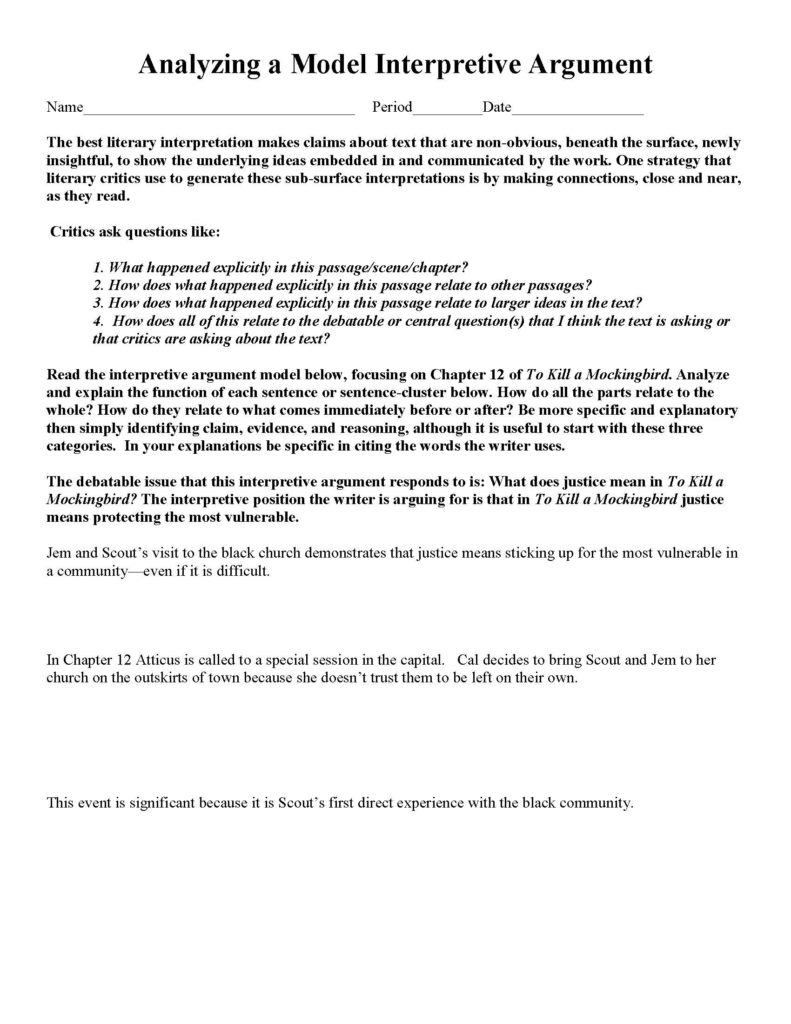
Analyzing a Model Interpretive Argument on ‘To Kill A Mockingbird’
At one of Argument-Centered Education’s partner schools, Daniel Hale Williams College Prep in Chicago, I have been working extensively this year with a young and rising-star English teacher by the name of Thom Connor. Mr. Connor has been absorbing argument pedagogy and he has been making it his own, innovating a series of activities and assessments with his English I (9th grade), English II (10th grade), and AP Language & Composition (11th grade) students. I have been collaborating with him on revising and refining these resources. What is coming out of his inventions, and our collaborations, is having an increasingly apparent big impact on the teaching and learning in his classrooms. One such resource innovation is the activity we’ve called Analyzing a Model Interpretive Argument.
The example of Analyzing a Model Interpretive Argument we will look at here is part of an English II unit on To Kill a Mockingbird. This assessment, though, is completely adaptable. It literally can be used with any unit in any course. In its principle of design is that it begins with a description of discipline-specific skills that the teacher wants students to learn, know, and demonstrate in their argumentation in the unit. It then includes the debatable issue in the unit, and a sample position in response to the DI. The academic meat of it is students analyzing each sentence or sentence-cluster of a model interpretive (or historical, scientific, or another) argument, explaining in close detail what they think each one is doing in the argument, what work it is performing.

Of course the model interpretive (or historical, scientific, or another) argument is constructed very deliberately by you, the teacher. There are several criteria for constructing these model arguments to consider.
Exemplify the skills you highlight in the assessment’s first section. The assessment should be all of a piece, coherently asking students to demonstrate understanding of, and assessing their performance with, the argumentation skills that the unit or project is emphasizing.
Cluster each part of the argument so that it asks the students to analyze a discrete function. Avoid sentences in the argument that are redundant. Make each sentence or sentence-cluster perform its own, additional work toward making the overall argument. You can see how this example succeeds on this criterion by taking a close look at the Answer Key below.
Take the “model” aspect of the assessment seriously. This activity asks students to think carefully and meta-cognitively about how strong academic arguments are built and what each piece of them does. It should — and will, if the activity is used at least somewhat routinely — build and refine students’ own image of effective academic argumentation. So be sure that you are modeling academic argument that, while not well beyond students’ developmental levels, is stretching them toward a higher version of their capacity.
To achieve these criteria (and more), I strongly recommend doing the extra work to produce a full Answer Key for yourself. This will test that each sentence or sentence-cluster in your model is right, and it will help you think meta-cognitively about what kind of thinking you want and expect from your students. Take a close look at our Answer Key on this To Kill a Mockingbird example to see what I mean.


